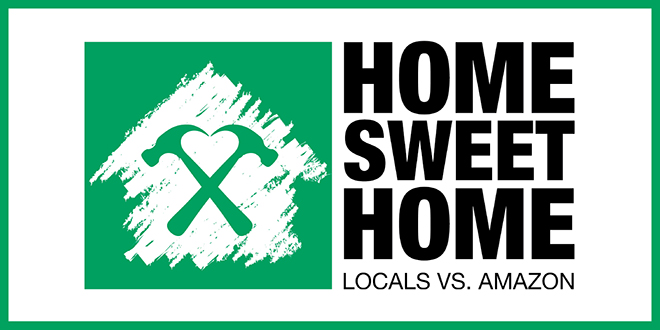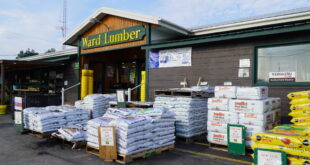A newly released study, Home Sweet Home: Locals vs. Amazon, examines the powerful local impact consumers make when purchasing home improvement products at independent businesses instead of on Amazon.
The new research reinforces the value of the local economic advantage small independent businesses provide, showing their rate of return to local communities through labor, profit, procurement and charity—a contribution that is nearly seven times greater than what Amazon offers.
Amazon recently reported its positive impact on the larger U.S. economy through its small business sellers, but the Locals vs. Amazon study shows that buying directly from independent businesses in stores or online has an even greater economic impact.
The North American Retail Hardware Association (NRHA), shop-local organization Independent We Stand and the Paint and Decorating Retailers Association partnered to produce the Locals vs. Amazon research.
Highlights From the Study
- Sales through local hardware and paint dealers have a local impact nearly seven times greater (676 percent) than sales through Amazon, according to the study.
- If Amazon were to capture just 10 percent of the home improvement market from independents, American communities would see a loss of $9.3 billion in local economic activity.
- Because about half of Amazon’s sales come from third-party sellers who collect sales tax on a very limited basis, states and communities would see a substantial loss of revenue if those sales shifted from independents to Amazon.
- When consumers order home improvement products online from an independent business, their money has more than twice (130 percent higher) the impact on local economies through jobs, taxes, charitable giving and revenue than if they were to buy online from Home Depot or Lowe’s.
- Total e-commerce sales across all lines of goods accounted for only 8.9 percent of all U.S. retail sales in 2017.
- Online sales from independent home improvement dealers and major chains, combined, represent only 2.3 percent of overall online retail sales.
“Clearly, Amazon is feeling the pressure from America’s independent businesses, which provide their communities with substantial, quantifiable economic benefits relative to their chain competitors and even more substantial benefits as compared to online competitors like Amazon,” says Bill Brunelle, co-founder of Independent We Stand.
“Locals vs. Amazon has produced stunning findings which allow us to follow the dollars into the economy, giving us perspective on not only the local advantage impact of independent businesses, but also the real numbers when it comes to online sales in the U.S.,” Brunelle says.
Data in the study shows the hardware, paint and power equipment sectors are somewhat insulated compared to other industries and supports the broad assertion that home improvement and building materials customers buck the trend of increasing online shopping.
“From experience and product knowledge to troubleshooting and customer service, independent retailers have several advantages over Amazon and online sales. This study clearly shows the consumer still wants to go to a brick-and-mortar independent paint or hardware store to make their purchases,” says LeAnn Day, CEO of the Paint and Decorating Retailers Association (PDRA). “I believe consumers want to buy local and support local businesses and value the level of trust they develop through their experiences with locals.”
Customers want to inspect products before purchasing them, and they likely visit a trusted retailer for expertise and advice on home improvement purchases. In addition, big-box home center chains have developed sophisticated tools to facilitate hybrid online sales for in-store pickup.
“We are not ignoring e-commerce. As it becomes a greater concern for independent retailers in our sector who may have limited capabilities, we’ve worked hard to create effective research that accurately depicts the economic influence locally owned businesses have on an individual community and how that initial impact has the potential to generate national economic activity,” says Dan Tratensek, NRHA vice president and publisher of Hardware Retailing magazine.
“This Locals vs. Amazon edition of our Home Sweet Home Study shows how critical it is for retailers and consumers alike to be aware of the impact we make when we choose to shop local.”
View the Home Sweet Home: Locals vs. Amazon study here.
About the Study
Economic analysis and strategic planning firm Civic Economics conducted the Home Sweet Home: Locals vs. Amazon study. The North American Retail Hardware Association (NRHA), the Paint and Decorating Retailers Association (PDRA) and Independent We Stand commissioned the study.
The study is the third in a series of Home Sweet Home studies. The first two studies, Home Sweet Home in 2015 and Home Sweet Home Pros’ Edition in 2017, provided extensive analyses comparing the local economic impact of conducting business through independent businesses versus a major national chain.
The Locals vs. Amazon edition of the study builds on the prior analyses and expands the research to include e-commerce sales through Amazon.
By calculating the percentage of revenue that recirculates in local economies through independent retailers, national chain retailers and Amazon, the study quantifies the local advantage of four major activities: labor, profit, procurement and charity.
 Hardware Retailing The Industry's Source for Insights and Information
Hardware Retailing The Industry's Source for Insights and Information








